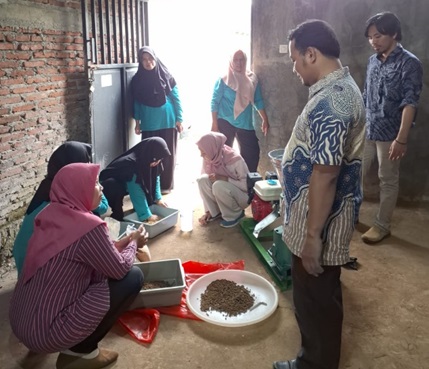Penerapan Mesin Pembuatan Pakan Ikan Alternatif pada Kelompok Wanita Tani “Makmur Berkah” di Desa Kutasari Kecamatan Baturraden Implementation of an Alternative Fish Feed Making Machine in the "Makmur Berkah" Farming Women's Group in Kutasari Village, Baturraden District
Main Article Content
Abstract
KWT Makmur Berkah is involved in agriculture and fisheries, utilizing land of 150 tiles (approximately 2,100 m²). In agriculture, members cultivate peanuts, chili peppers, and vegetables. In fisheries, they practice polyculture with various fish species. Currently, the fish feed used is a mix of kitchen spices and pellets. Interviews revealed that the feeding practices are suboptimal, as they focus solely on increasing fish size without addressing nutritional quality. This community service project aims to improve the knowledge and skills of KWT Makmur Berkah members in producing alternative fish feed. The project began with an overview of the importance of high-quality fish feed, followed by training in the production of alternative feed. Participants then took part in demonstrations and hands-on practice with fish feed pellet machines and learned how to maintain these machines. After the initial implementation, monitoring and evaluation were carried out, alongside periodic support to ensure the program’s ongoing success. A total of 20 KWT Makmur Berkah members participated in the project. The project’s results were significant. Participants, particularly women, not only successfully learned to operate the feed pellet machines independently but also reported high levels of satisfaction with the tool’s ease of use and efficiency. Feedback from the training was overwhelmingly positive, with many members noting that the program significantly enhanced their fish farming practices.
Downloads
Article Details

This work is licensed under a Creative Commons Attribution-ShareAlike 4.0 International License.
Authors who publish with this journal agree to the following terms:
- Any article on the copyright is retained by the author(s).
- Author grant the journal, right of first publication with the work simultaneously licensed under a Creative Commons Attribution License that allows others to share work with acknowledgment of the work authors and initial publications in this journal.
- Authors are able to enter into a separate, additional contractual arrangements for non-exclusive distribution of published articles of work (eg, post-institutional repository) or publish it in a book, with acknowledgment of its initial publication in this journal.
- Authors are permitted and encouraged to post their work online (e.g., in institutional repositories or on their websites) prior to and during the submission process, as can lead to productive exchanges, as well as earlier and greater citation of published work.
- The article and any associated published material is distributed under the Creative Commons Attribution-ShareAlike 4.0 International License
References
Abidin, Z., Hasan, M., & Wibowo, R. (2022). Pemanfaatan limbah agroindustri sebagai bahan baku pakan ikan: Studi kasus dan analisis biaya. Journal of Aquaculture and Fisheries, 19(2), 45-58.
Arief, M., Fitriani, N., & Subekti, S. (2014). Pengaruh pemberian probiotik berbeda pada pakan komersil terhadap pertumbuhan dan efisiensi pakan ikan lele Sangkuriang (Clarias sp.). Jurnal Ilmiah Perikanan dan Kelautan, 6(1), 49-53. https://dx.doi.org/10.20473/jipk.v6i1.11381
Arief, M., Ratika, A. N., & Lamid, M. (2012). Pengaruh kombinasi media bungkil kelapa sawit dan dedak padi yang difermentasi terhadap produksi maggot black soldier fly (Hermetia illucens) sebagai sumber protein pakan ikan. Jurnal Ilmiah Perikanan dan Kelautan, 4(1), 33-38. https://dx.doi.org/10.20473/jipk.v4i1.11580
Hanif, H., Nurdin, N., & Mawardi, I. (2014). Pengabdian Bagi Petani Ikan Bandeng Desa Jambo Timu Pemkot Lhokseumawe Yang Menghadapi Masalah Tingginya Harga Pakan Ikan. Prosiding SNaPP: Sains, Teknologi, 4(1), 299-306.
Handayani, R., & Kusuma, D. (2023). Intensive support programs for adoption of new feed technologies. Community Development and Support Journal, 30(2), 89-101.
Mogaji, K., Kehinde, J. I., & Jimoh, A. M. (2020). Development of an Improved Fish Feed Pelletizing Machine. Journal of Aquaculture Research, 11(3), 198-213.
Mulyono, A., Prasetyo, H., & Lestari, E. (2023). Innovation in fish feed formulation using local resources. Indonesian Journal of Aquaculture, 14(2), 78-88.
Mulia, D. S., Yulyanti, E., Maryanto, H., & Purbamartono, C. (2015). Peningkatan kualitas ampas tahu sebagai bahan baku pakan ikan dengan fermentasi Rhizopus oligosporus. Sainteks, 12(1). http://dx.doi.org/10.30595/sainteks.v12i1.83
Mulia, D. S., Yuliningsih, R. T., Maryanto, H., & Purbomartono, C. (2016). Pemanfaatan limbah bulu ayam menjadi bahan pakan ikan dengan fermentasi Bacillus subtilis. Jurnal Manusia dan Lingkungan, 23(1), 49-57. https://doi.org/10.22146/jml.18773
Okolie, P. C., Chukwujike, I. C., Chukwuneke, J. L., & Dara, J. E. (2019). Design and production of a fish feed pelletizing machine. Heliyon, 5(6). http://dx.doi.org/10.1016/j.heliyon.2019.e02001
Rahman, A., Alim, M., & Hossain, M. (2022). Local feed ingredients for aquaculture: Reducing dependency on imported feeds. Sustainable Aquaculture Journal, 11(3), 95-104.
Sudirman, A., Nurdin, I., & Wicaksono, F. (2023). Polyculture systems in aquaculture: Management practices and outcomes. Aquaculture Management and Technology, 29(2), 55-66.
Tambunan, T., Kartika, A., & Yuliana, S. (2022). Effect of feed management on polyculture fish production. Journal of Sustainable Fisheries, 17(3), 112-123.
Warasto, M., Prabowo, S., & Suryani, E. (2021). Development of cost-effective alternative feeds for aquaculture. Aquaculture Economics & Management, 26(4), 215-230.
Warasto, Y., Yulisman, & Mirna, F. (2013). Tepung Kiambang (Salvinia molesta) Terfermentasi sebagai Bahan Pakan Ikan Nila (Orechromis niloticus). Jurnal Akuakultur Indonesia, 1(2), 173-183.
Widodo, S., Nurcahyo, B., & Wulan, S. (2022). Cost reduction in fish feed through the use of local ingredients. Fisheries Science Review, 18(1), 34-47.
Yunaidi, E. (2019). Feed as a major constraint in intensive aquaculture production*. Aquaculture Reports, 15(2), 43-51.
Yusuf, A., & Hartono, B. (2022). The role of community-based training in enhancing fish farming sustainability. Journal of Rural Development, 27(1), 59-71.
Zidni, N. (2016). *The impact of imported raw materials on fish feed costs*. Journal of Fishery Economics, 22(1), 78-85.
